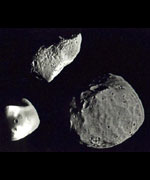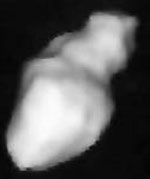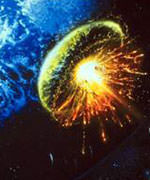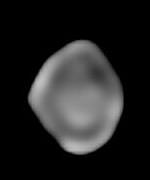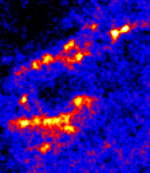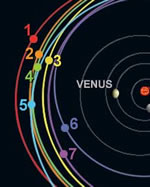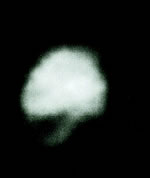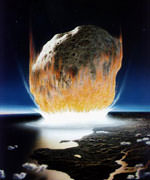
Image credit: NASA
Most paleontologist believe that a gigantic asteroid struck Mexico 65 million years ago and killed all the dinosaurs; end of story. But a minority believe that the Earth’s environment was already uncomfortable for dinosaurs because of a series of asteroid strikes and volcano eruptions – the asteroid was just the straw that broke the camel’s back. By studying the life spans of colonies of one-celled organisms, paleontologist Gerta Keller has uncovered that the Cretaceous period might have lasted 300,000 years after the asteroid impact.
As a paleontologist, Gerta Keller has studied many aspects of the history of life on Earth. But the question capturing her attention lately is one so basic it has passed the lips of generations of 6-year-olds: What killed the dinosaurs?
The answers she has been uncovering for the last decade have stirred an adult-sized debate that puts Keller at odds with many scientists who study the question. Keller, a professor in Princeton’s Department of Geosciences, is among a minority of scientists who believe that the story of the dinosaurs’ demise is much more complicated than the familiar and dominant theory that a single asteroid hit Earth 65 million years ago and caused the mass extinction known as the Cretacious-Tertiary, or K/T, boundary.
Keller and a growing number of colleagues around the world are turning up evidence that, rather than a single event, an intensive period of volcanic eruptions as well as a series of asteroid impacts are likely to have stressed the world ecosystem to the breaking point. Although an asteroid or comet probably struck Earth at the time of the dinosaur extinction, it most likely was, as Keller says, “the straw that broke the camel’s back” and not the sole cause.
Perhaps more controversially, Keller and colleagues contend that the “straw” — that final impact — is probably not what most scientists believe it is. For more than a decade, the prevailing theory has centered on a massive impact crater in Mexico. In 1990, scientists proposed that the Chicxulub crater, as it became known, was the remnant of the fateful dinosaur-killing event and that theory has since become dogma.
Keller has accumulated evidence, including results released this year, suggesting that the Chicxulub crater probably did not coincide with the K/T boundary. Instead, the impact that caused the Chicxulub crater was likely smaller than originally believed and probably occurred 300,000 years before the mass extinction. The final dinosaur-killer probably struck Earth somewhere else and remains undiscovered, said Keller.
These views have not made Keller a popular figure at meteorite impact meetings. “For a long time she’s been in a very uncomfortable minority,” said Vincent Courtillot, a geological physicist at Universit? Paris 7. The view that there was anything more than a single impact at work in the mass extinction of 65 million years ago “has been battered meeting after meeting by a majority of very renowned scientists,” said Courtillot.
The implications of Keller’s ideas extend beyond the downfall of ankylosaurus and company. Reviving an emphasis on volcanism, which was the leading hypothesis before the asteroid theory, could influence the way scientists think about the Earth’s many episodes of greenhouse warming, which mostly have been caused by periods of volcanic eruptions. In addition, if the majority of scientists eventually reduce their estimates of the damage done by a single asteroid, that shift in thinking could influence the current-day debate on how much attention should be given to tracking and diverting Earth-bound asteroids and comets in the future.
Keller does not work with big fossils such as dinosaur bones commonly associated with paleontology. Instead, her expertise is in one-celled organisms, called foraminifera, which pervade the oceans and evolved rapidly through geologic periods. Some species exist for only a couple hundred thousand years before others replace them, so the fossil remains of short-lived species constitute a timeline by which surrounding geologic features can be dated.
In a series of field trips to Mexico and other parts of the world, Keller has accumulated several lines of evidence to support her view of the K/T extinction. She has found, for example, populations of pre-K/T foraminifera that lived on top of the impact fallout from Chicxulub. (The fallout is visible as a layer of glassy beads of molten rock that rained down after the impact.) These fossils indicate that this impact came about 300,000 years before the mass extinction.
The latest evidence came last year from an expedition by an international team of scientists who drilled 1,511 meters into the Chicxulub crater looking for definitive evidence of its size and age. Although interpretations of the drilling samples vary, Keller contends that the results contradict nearly every established assumption about Chicxulub and confirm that the Cretaceous period persisted for 300,000 years after the impact. In addition, the Chicxulub crater appears to be much smaller than originally thought — less than 120 kilometers in diameter compared with the original estimates of 180 to 300 kilometers.
Keller and colleagues are now studying the effects of powerful volcanic eruptions that began more than 500,000 years before the K/T boundary and caused a period of global warming. At sites in the Indian Ocean, Madagascar, Israel and Egypt, they are finding evidence that volcanism caused biotic stress almost as severe as the K/T mass extinction itself. These results suggest that asteroid impacts and volcanism may be hard to distinguish based on their effects on plant and animal life and that the K/T mass extinction could be the result of both, said Keller.
Original Source: Princeton News Release

